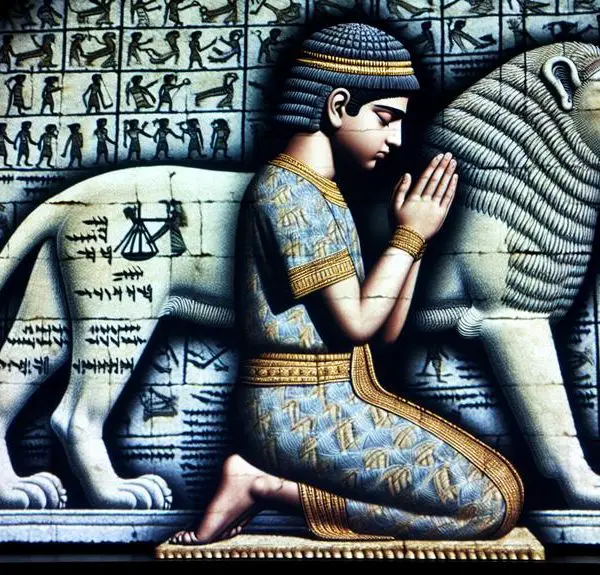Uncover the symbolic power of eagles in the Bible, exploring their divine characteristics and what these majestic birds represent.

Characteristics of an Eagle in the Bible
In the vast tapestry of biblical narratives, the eagle emerges not merely as a bird but as a profound symbol of divine strength and renewal.
You'll find its wings carry more than the promise of height; they embody an emblem of protection, a metaphor for soaring faith, and an example of visionary leadership.
As you explore these characteristics further, consider how they reflect not just on the spiritual but also on the personal aspects of life.
What lessons can you draw from this majestic creature that seem tailor-made for the challenges you face today?
This inquiry may just offer the insights you're seeking.
Key Takeaways
- Eagles symbolize divine strength, protection, and guidance, reflecting God's sovereignty.
- They represent spiritual renewal and rejuvenation, shedding old selves for transformation.
- Eagles signify resilience and transcendence, soaring above trials and adversities.
- Their keen vision and high flight illustrate visionary leadership and divine swiftness.
Symbol of Divine Strength

In the biblical context, the eagle symbolizes divine strength, serving as a potent metaphor for God's unwavering support and might. You'll find the imagery of the eagle is intricately woven into the fabric of scripture to convey themes of protection, guidance, and sovereignty. The eagle's heavenly ascent, a remarkable feat of nature, mirrors the spiritual elevation believers experience through divine grace. This ascent isn't merely about altitude but signifies a closer proximity to the divine, an elevation above worldly concerns and troubles.
The sovereign gaze of the eagle, capable of discerning its prey from great distances, parallels the omniscient view of the divine. Just as the eagle oversees its domain with unmatched clarity and foresight, God's vision encompasses all of creation, past, present, and future. This gaze isn't passive; it signifies an active engagement and a profound understanding of the intricacies of the world.
Analyzing the biblical use of the eagle metaphor, it's evident that its significance extends beyond mere strength. It encapsulates a multi-faceted representation of God's nature—His protection, guidance, and foresight. The eagle's ability to soar at great heights, unaffected by the storms below, offers a vivid illustration of transcendence over trials and tribulations. This divine strength isn't just an abstract concept but a tangible presence that elevates and empowers believers, offering them a sovereign gaze over their own lives, guided by the wisdom and strength that comes from a higher power.
Emblem of Renewal

In the biblical context, the eagle emerges as a powerful emblem of renewal.
You'll observe how its representation intertwines with themes of spiritual rebirth, signifying profound transformation and growth.
This imagery not only enriches the textual analysis but also deepens our understanding of the scripture's multifaceted teachings on renewal.
Symbolism of Renewal
One often encounters the eagle in the Bible as a powerful emblem of renewal, symbolizing the transformative power of faith and the divine promise of rejuvenation. This majestic creature embodies not just the literal strength and longevity it's known for but also serves as a poignant aging metaphor within Nature's cycle. Through this lens, the eagle offers profound insights:
- The shedding of old feathers as a metaphor for casting off the old self
- The renewal of strength that mirrors spiritual renewal
- The eagle's soaring heights as an allegory for ascending faith
- The cyclical nature of life and rejuvenation reflected in the eagle's life stages
Analyzing the eagle's role provides a rich, contextual understanding of renewal, deeply embedded in the fabric of biblical narratives.
Spiritual Rebirth Significance
Building on the symbolism of renewal, the eagle's emblematic significance extends deeply into the realm of spiritual rebirth, highlighting the profound transformation individuals undergo through faith. This majestic bird, often associated with soaring heights and freedom, serves as a metaphor for the spiritual awakening that believers experience.
Through rebirth rituals, such as baptism in Christianity, followers symbolically shed their old selves, akin to the eagle renewing its feathers. These practices aren't merely ceremonial; they're pivotal moments of commitment, signifying a believer's willingness to embrace a new path of enlightenment and purity.
Just as the eagle emerges stronger, individuals undergoing spiritual rebirth are said to attain a heightened sense of purpose and connection with the divine, illustrating a transformative journey of renewal and awakening.
Transformation and Growth
Embodying the essence of metamorphosis, the eagle symbolizes not just renewal, but a profound transformation and growth that believers aspire to through spiritual practices.
- Molting Process: This natural phenomenon, where eagles shed old feathers for new growth, mirrors the spiritual shedding of past burdens and sins for a renewed life.
- Nesting Habits: Eagles meticulously prepare their nests, representing the careful, deliberate steps one must take in their own life for spiritual growth and transformation.
- Renewal of Strength: Just as eagles regain strength after molting, individuals are encouraged to find new strength in their faith and beliefs.
- Visionary Growth: The eagle's sharp vision symbolizes the clarity and foresight one gains through spiritual transformation, seeing beyond the immediate to grasp the eternal.
Representation of Speed

You'll find that the Bible frequently employs the image of the eagle to denote not just renewal, as previously discussed, but also remarkable speed. This symbolism in scripture often aligns with divine swiftness, illustrating how swiftly God can act in the lives of believers.
Furthermore, eagles in prophecy underscore the urgency and rapid unfolding of divine plans, offering a vivid depiction of speed that transcends mere physical velocity.
Symbolism in Scripture
In Scripture, the eagle often symbolizes speed, embodying divine qualities and messages delivered swiftly across the heavens. Ancient interpretations and cultural comparisons enrich our understanding of this symbolism, showcasing the eagle's role as a messenger of the divine, capable of transcending earthly bounds with grace and alacrity.
- *Ancient interpretations* highlight the eagle's connection to divine wisdom, illustrating its role in conveying celestial messages.
- *Cultural comparisons* reveal how various societies have recognized the eagle's speed as a representation of divine intervention.
- This symbolism underlines the eagle's ability to navigate the skies effortlessly, mirroring the swift delivery of divine will.
- The eagle's depiction in Scripture as a swift creature serves to remind us of the speed at which divine messages can transcend human understanding, urging us to look beyond the immediate.
Divine Swiftness Illustrated
Building on the eagle's symbolism of divine speed, we now explore how this representation of swiftness illustrates the profound ability of divine messages to transcend earthly limitations and time.
This celestial agility mirrors God's velocity in manifesting His will and delivering His word across the vast expanse of creation. The eagle's rapid flight isn't just a marvel of nature but a metaphor for the instantaneous reach of the divine, bridging the gap between the heavens and the earth with remarkable speed.
This imagery emphasizes the notion that God's interventions and guidance aren't hindered by the physical laws that govern our world, showcasing an omnipotence that operates beyond our comprehension of time and space. Thus, the eagle becomes a symbol of divine swiftness, embodying the seamless connection between the celestial and the terrestrial.
Eagles in Prophecy
Throughout biblical prophecy, eagles often symbolize the remarkable speed with which divine messages are conveyed to humanity, serving as a vivid illustration of God's swift communication and intervention in the world. This metaphor enriches the text, adding layers of meaning and enriching the reader's understanding of the divine narrative.
- Eagles' swift flights mirror the speed of divine revelations reaching prophets.
- Their keen sight parallels the clarity and foresight in future predictions.
- The sudden swoop of an eagle exemplifies the unexpected, yet precise, nature of prophetic accuracy.
- Eagles soaring high and alone symbolize the unique and direct communication between God and His prophets, untainted by worldly influences.
These elements together paint a vivid picture of the dynamic and powerful way God's messages have been historically conveyed through prophecy.
Illustration of Protection

How does the Bible depict eagles as symbols of divine protection, and what implications does this have for understanding biblical narratives? In the spiritual landscape of the Bible, eagles aren't just birds; they're profound symbols of God's safeguarding presence. This imagery draws on the natural world, where eagles are known for their meticulous nesting habits and remarkable parental care. These traits aren't merely ornithological facts but serve as a metaphor for divine oversight and protection.
Eagles construct their nests in high places, away from potential threats, symbolizing a place of safety provided by God. Their high vantage points offer protection and a perspective beyond the immediate surroundings. This mirrors the biblical notion that God watches over His people, lifting them above life's dangers.
The parental care of eagles is equally symbolic. Eagles are vigilant in caring for their young, teaching them to fly by encouraging them to leave the nest while ready to swoop down and catch them if they falter. This vividly illustrates God's protective nature as described in the Bible. He encourages growth and independence while always being present to catch His followers should they fall.
Understanding these characteristics of eagles deepens the interpretation of biblical texts, revealing a layer of meaning that emphasizes God's protective qualities. It's not just about the physical traits of these magnificent birds but what they signify in the spiritual journey of faith. The depiction of eagles in the Bible, therefore, isn't just ornamental but deeply embedded in the narrative's theology, offering insights into the nature of divine protection and care.
Metaphor for Soaring Faith

In the biblical narrative, eagles soaring high above the Earth serve as a powerful metaphor for the uplifting nature of faith that elevates believers above worldly concerns. This imagery isn't chosen at random. Eagles are known for their strength, resilience, and ability to ascend great heights. Similarly, faith empowers individuals to transcend the mundane, offering a perspective that sees beyond immediate trials and tribulations.
The metaphor of the eagle in flight encapsulates several key aspects:
- Resilience in the face of adversity: Just as eagles use the force of the storm to lift them higher, faith provides the strength to face life's challenges head-on.
- Vision that transcends the immediate: Eagles possess keen eyesight, symbolizing the foresight and clarity faith offers, guiding believers through uncertain times.
- Soaring above the fray: Eagles fly at elevations that other birds can't reach, illustrating how faith elevates the spirit above worldly concerns and petty disputes.
- Renewal and rebirth: Eagles are often associated with renewal, as their strength and youthfulness seem to renew with age, mirroring how faith can rejuvenate the spirit and offer a fresh start amidst life's cycles.
Analyzing this metaphor, it's clear that faith challenges and soaring obstacles aren't to be viewed as impediments but rather as opportunities for growth and elevation. This perspective shifts the focus from the burdens of the present to the promises of the future, embodying the essence of hope and resilience that faith instills in the hearts of believers.
Example of Visionary Leadership

Eagles' ability to soar above the highest altitudes mirrors the visionary leadership qualities that guide communities through times of uncertainty and change. You, as a leader, can draw inspiration from these majestic birds to navigate through challenges with grace and foresight. Leadership qualities are not just about managing tasks but also about embodying the vision that propels the group forward. Vision implementation becomes crucial in translating abstract ideas into concrete actions.
Eagle Trait |
Leadership Quality |
Application in Visionary Leadership |
|---|---|---|
Keen Vision |
Strategic Insight |
Identifying long-term opportunities and threats. |
High Flight |
Perspective |
Maintaining an overview of complex situations. |
Solitary Flight |
Independence |
Making tough decisions without swaying to popular opinion. |
Renewal Process |
Adaptability |
Embracing change and innovation for continuous improvement. |
This table encapsulates how the characteristics of eagles align with essential leadership qualities. A visionary leader, much like an eagle, possesses the strategic insight to spot opportunities from afar. You're not just reacting to immediate challenges but also planning several steps ahead, ensuring your community or organization is well-positioned for future success.
Moreover, your ability to maintain perspective, akin to an eagle's high flight, allows you to oversee and understand the intricate dynamics at play. This broad viewpoint is crucial for effective vision implementation, ensuring that each step taken is aligned with the overarching goals.
Frequently Asked Questions
How Do Different Translations of the Bible Vary in Their Depiction of Eagles and What Impact Does This Have on the Interpretation of Their Symbolism?
Different Bible translations use varied methodologies, leading to distinct portrayals of eagles. This divergence impacts the symbolism you might interpret from the text. Translation methodologies can emphasize certain aspects over others, causing symbolic variations that affect understanding.
As you delve into these translations, you'll find that nuances in language can significantly alter the symbolic weight eagles carry, enriching or complicating your interpretation of their representation within biblical narratives.
Are There Any Historical or Cultural Contexts Outside of the Bible That Influenced Its References to Eagles, and How Do These Contexts Affect Our Understanding of These Biblical Symbols?
As they say, 'A bird in the hand is worth two in the bush,' understanding eagles' portrayal requires examining their historical and cultural significance outside biblical texts.
Eagle conservation efforts and zoological accuracy have shed light on these majestic birds, influencing their symbolic interpretation in ancient cultures.
This background enriches our comprehension of biblical symbols, revealing how eagles' characteristics weren't just randomly chosen but deeply rooted in the society's values and knowledge.
How Do the Characteristics of Eagles in the Bible Compare to Those Attributed to Them in Other Ancient Religions and Mythologies?
You're exploring how eagle characteristics in ancient religions and mythologies parallel those in the Bible, without diving into biblical specifics.
Looking at eagle migrations, you'll uncover fascinating mythological parallels. These majestic birds are often symbols of power and renewal across cultures.
In What Ways Have Modern Christian Teachings and Sermons Expanded Upon or Diverged From the Biblical Characteristics of Eagles?
In modern Christian teachings, you'll find that sermons and discussions have broadened the interpretation of eagles beyond their biblical characteristics. They've woven in aspects like eagle conservation, emphasizing stewardship of God's creation, and flight mechanics to illustrate principles of faith and spiritual upliftment.
This expansion reflects a deeper engagement with the natural world and a desire to apply scriptural metaphors in ways that resonate with contemporary environmental and scientific understandings.
Can the Characteristics of Eagles in the Bible Be Correlated With Any Specific Biblical Characters or Stories, and How Are These Associations Interpreted in Theological Studies?
You might find it intriguing how eagle metaphors soar through biblical narratives, embodying strength and renewal.
Scholars often correlate these majestic birds with characters like Moses, lifting people's spirits, or prophets, who navigate turbulent times with keen insight.
Prophetic interpretations further enrich this symbolism, offering layers of meaning that delve deep into faith's journey.
Analyzing these connections sheds light on the intricate tapestry of theological studies, where every symbol holds profound significance.
Conclusion
In conclusion, the eagle in the Bible emerges not just as a bird but as a celestial emblem, encapsulating divine strength, renewal, swiftness, protection, soaring faith, and visionary leadership.
You've seen how it embodies qualities that transcend earthly bounds, offering a hyperbolic leap into spiritual magnificence.
This analysis deciphers its symbolic significance, urging you to embrace these attributes in your life's journey.
Thus, the eagle doesn't merely fly; it soars across the heavens, inviting you to rise above mundane existence towards divine actualization.



Sign up